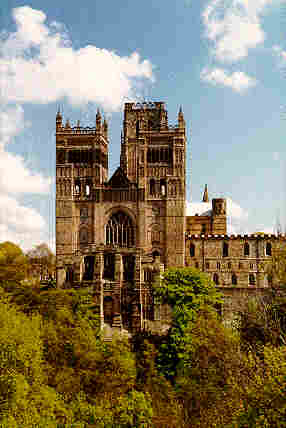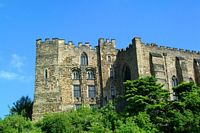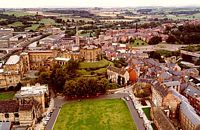
| Durham Cathedral Sanctuary in the Cathedral |
| Home Page |
| Contact Us |
| Links |
| Lodge History |
| Gallery |
| Calendar of Events |
| Guestbook |
| About Freemasonry |
| UGLE Website |

Durham Castle

Durham Castle
|
As the North Door is approached, there is an excellent opportunity
to take in the whole of the Cathedral building. The present structure
was built on the site of the earlier Saxon 'White Church', to be both
a magnificent shrine for the body of St Cuthbert and also home for
a community of Benedictine monks. Planned and begun by Bishop Carileph
(1081-1096), the Cathedral was largely constructed out of Low Main
Post sandstone which was quarried locally. It was completed in five
main stages: The Nave, Transepts and the Choir built: 1093-1133 The Galilee Chapel at the west end built: 1173-1189 The Western Towers built: 1217-1226 The Chapel of the Nine Altars at the east end built: 1242-1274 The Central Tower largely rebuilt: 1465-1490. The North Door dates back to 1140. It is surrounded by a carved stone doorway made up of a series of five orders of arches and pillars. One of the most striking features of the North Door itself is the bronze, lion-like Sanctuary Knocker attached to the outside. Throughout the Middle Ages, Durham Cathedral was a place of sanctuary. A fugitive from the law wishing to claim protection used the knocker to attract the attention of two watchmen in a chamber over the North Door. He was then admitted to the Monastery and given sanctuary for a maximum of thirty seven days during which time he had to choose between trial and voluntary exile. If he chose the latter, he was escorted to a port - usually the Bishop's port at Hartlepool - wearing a badge in the shape of the cross of St Cuthbert stitched to his shoulder and carrying a rough wooden cross tied together with rope. Once at the port, he was required to embark on the next ship that was due to set sail regardless of its destination. The Sanctuary Knocker attached to the front of the North Door today is, in fact, an exact copy of the original and was placed there in 1980. The original itself is on display in the Cathedral's museum. "Perched high above the River Wear, the cathedral represents one of the most powerful and moving architectural images in Britain. Although nearly 1,000 years old, its interior seems strikingly modern and sculptural, and immensely rich in meaning" .(BBC History Website) |